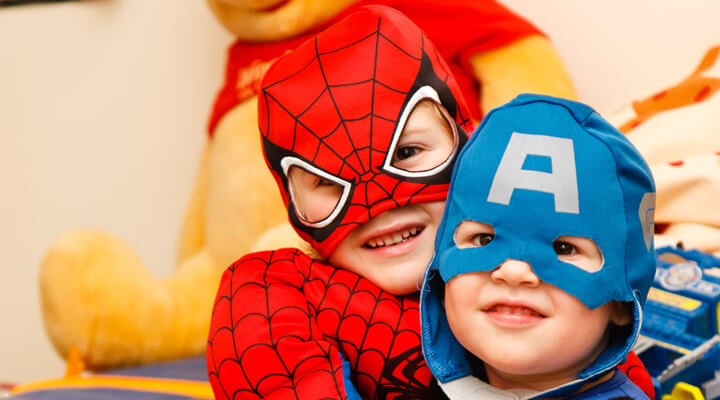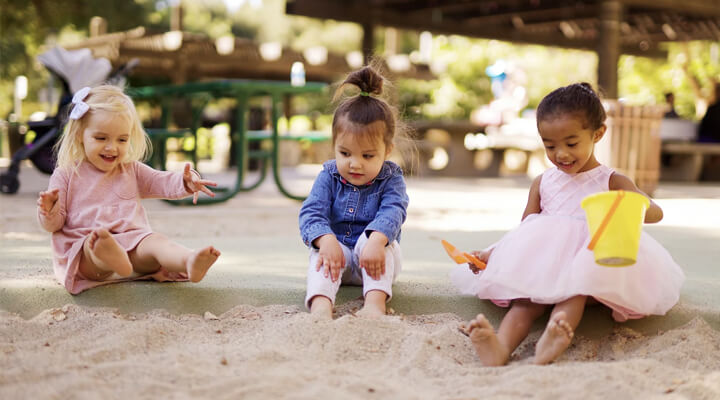Children's Role Play and its Importance in the Playground
Role play provides a creative way for children to progress their social and intellectual development. Role play is often inspired by factors such as themed playgrounds or fancy dress. It involves children making up a storyline and acting this out with their friends. There are three generally accepted types of kids role play:
1: Occupational
Occupations such as doctors, firefighters, chefs and so on are usually popular job roles that children imitate when role playing. Firstly, this encourages language development. This is because children pick up words associated with these job roles. But also, it reinforces the concept of empathy and selflessness for children. This is especially true if the profession they are role playing is a job that helps others – such as a nurse, for example.
2: Fantasy
Fantasy role play is usually inspired by films, TV, or fiction books. We’ve all seen a horde of kids dressed as their favourite superheroes! This is usually a great way to encourage playing together with other children. It also teaches conflict resolution. Because there can’t be a superhero without a villain!

3: Real Life
Children can also be inspired by what they see in day-to-day life, and this can transpire over to the playground. Whether this is acting out grocery shopping or lollipop ladies, it turns children’s natural inquisitiveness and observation habits into play scenarios. Ultimatley, this helps them become better at communicating and understanding real-life habits they will need as they grow up.
The Benefits of Role Play
Role play helps progress a number of key developmental skills. Including but not limited to intellectual, communicative, social and language skills.
In terms of physical development, role play can help build upon and improve children’s fine motor skills. For example: hand-eye coordination and sense of balance. Playing with props or having to jump and climb over playground equipment also means children become more adept at balancing, multitasking, coordinating.
This is also beneficial considering children need physical activity in order to keep up good levels of fitness for health development. Encouraging active play means children will be running, jumping and hopping from place to place. Therefore, they engage different muscle groups and keeping their heart rates up.
Language and communication skills will also improve as children socialise and play more. The more scenarios and situations they are exposed to, children will naturally evolve the way they communicate in order to express their feelings, wants adn needs. Therefore, developing thier ability to build on their relationship with others.
As they become more aware of other people and their feelings, and progress out of only being occupied with their own feelings, this can lead to children being more empathetic and sensitive. This could be sharing toys, taking turns using equipment, apologising if they upset or hurt someone, and so on.

How Playgrounds can Inspire Children’s Role Play
Role play relies on imagination, which young children often need an inspiration for. Young minds often need a spark for them to become inspired. Their surroundings are a very important aspect of this.
Dull, lifeless and boring surroundings won’t encourage children’s creativity and play. Instead, you should ensure your play space is a host for imaginative play to be inspired. If you need some inspiration for how you can make your playground a creative hub, look no further:
Bright colours
Children are drawn to bright and eye-grabbing colours from an early age. There is also plenty of research evidencing a preference for warm bright colours in childhood (see AOP). Because brighter colours stick out more, and children have showed their preference towards such colours over darker or duller ones, it makes sense that these should be implemented in the playground. For example, they could be incorporated through painting equipment in bright colours or using distinctive patterns on the safety surfacing.

Themes
Themed playgrounds are a popular trend that centre their equipment, patterns, colours and features around an overarching concept. For example, zoos usually have a safari-themed play area, or aquariums might have an under-the-sea theme. Themed playgrounds can create an exciting and immersive play environment. These can also be spaces where children can be inspired by their surroundings and create role play scenarios. Having props around them can help children think up stories and characters so they can play out themselves with their friends.
Zones
Splitting your playground into zones has a positive impact on imaginative play, and is beneficial for differentiating between various activities. A whole playground full of children will rarely all want to play the same game. Also, if there are no designated areas for different games, chaos could ensue! You should aim to split your playground into different sections – maybe one area for sports, one quiet area, one with props and toys – to indicate different areas for different activities, and encourage safer play.
As you can see, role play is a key component in children’s development. Therefore, it should be encouraged and facilitated on the playground. By providing an environment that stimulates imaginative play, children will grow in their cognitive capacities. They also develop relationships with the people around them, become acutely aware of the world beyond their own viewpoint, and stay active in order to keep developing healthily.
If you’re wanting to upgrade your existing playground to help promote role play, or you have a new project in mind. PlaySmart are keen to get you started – use the contact form below today!


